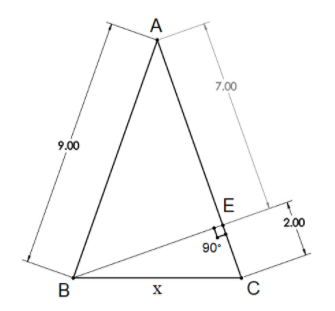
In the following figure of an isosceles triangle, find the value of $'x'$?
(All dimensions are in centimeter)


Answer
481.8k+ views
Hint: Notice that there are two right-angled triangles in the triangle $\Delta ABC$. They have a common side. Use Pythagoras’ theorem to find the measure of that side. Then use that value while applying Pythagoras’ theorem in another triangle to obtain the value of $'x'$.
Complete step-by-step answer:
Let’s analyse the question through the diagram first. Here we have an isosceles triangle $\Delta ABC$, which has an altitude $BE$ on the side $AC$. The altitude divides the $\Delta ABC$ into two right-angled triangles $\Delta BEC$ and $\Delta BEA$. Using all this information we need to find the value of $'x'$
If we notice $\Delta BEC$ in the figure, we can see that $x$ is the hypotenuse of this triangle.
Now we can use Pythagoras’ theorem that states that, “the sum of the squares of the sides of a right triangle is equal to the square on the hypotenuse”
Using Pythagoras’ theorem in $\Delta BEA$, we get:
$ \Rightarrow A{B^2} = B{E^2} + A{E^2}$
Now we can easily substitute the given values in the above equation
$ \Rightarrow {9^2} = B{E^2} + {7^2}$
$ \Rightarrow B{E^2} = 81 - 49 = 32$
$ \Rightarrow BE = \sqrt {32} = 4\sqrt 2 cm$
Similarly, again using Pythagoras’ theorem in $\Delta BEC$, we can see that:
$ \Rightarrow B{C^2} = B{E^2} + E{C^2}$
Let’s substitute the already known values in the above equation
$ \Rightarrow B{C^2} = {\left( {4\sqrt 2 } \right)^2} + {2^2} = 32 + 4 = 36$
$ \Rightarrow BC = x = 6 cm$
Hence, we got the value of $'x'$ as $6 cm$.
Note: Try to first understand all the given information in the diagram given in the question. Be careful while taking square root or squaring both sides in equations. An alternative approach to the problem is to apply Pythagoras’ theorem in both the right-angled triangles and equate for the value of $BE$. This will give you an equation with one unknown, i.e. $'x'$.
Complete step-by-step answer:
Let’s analyse the question through the diagram first. Here we have an isosceles triangle $\Delta ABC$, which has an altitude $BE$ on the side $AC$. The altitude divides the $\Delta ABC$ into two right-angled triangles $\Delta BEC$ and $\Delta BEA$. Using all this information we need to find the value of $'x'$
If we notice $\Delta BEC$ in the figure, we can see that $x$ is the hypotenuse of this triangle.
Now we can use Pythagoras’ theorem that states that, “the sum of the squares of the sides of a right triangle is equal to the square on the hypotenuse”
Using Pythagoras’ theorem in $\Delta BEA$, we get:
$ \Rightarrow A{B^2} = B{E^2} + A{E^2}$
Now we can easily substitute the given values in the above equation
$ \Rightarrow {9^2} = B{E^2} + {7^2}$
$ \Rightarrow B{E^2} = 81 - 49 = 32$
$ \Rightarrow BE = \sqrt {32} = 4\sqrt 2 cm$
Similarly, again using Pythagoras’ theorem in $\Delta BEC$, we can see that:
$ \Rightarrow B{C^2} = B{E^2} + E{C^2}$
Let’s substitute the already known values in the above equation
$ \Rightarrow B{C^2} = {\left( {4\sqrt 2 } \right)^2} + {2^2} = 32 + 4 = 36$
$ \Rightarrow BC = x = 6 cm$
Hence, we got the value of $'x'$ as $6 cm$.
Note: Try to first understand all the given information in the diagram given in the question. Be careful while taking square root or squaring both sides in equations. An alternative approach to the problem is to apply Pythagoras’ theorem in both the right-angled triangles and equate for the value of $BE$. This will give you an equation with one unknown, i.e. $'x'$.
Recently Updated Pages
What percentage of the area in India is covered by class 10 social science CBSE

The area of a 6m wide road outside a garden in all class 10 maths CBSE

What is the electric flux through a cube of side 1 class 10 physics CBSE

If one root of x2 x k 0 maybe the square of the other class 10 maths CBSE

The radius and height of a cylinder are in the ratio class 10 maths CBSE

An almirah is sold for 5400 Rs after allowing a discount class 10 maths CBSE

Trending doubts
The Equation xxx + 2 is Satisfied when x is Equal to Class 10 Maths

Why is there a time difference of about 5 hours between class 10 social science CBSE

Change the following sentences into negative and interrogative class 10 english CBSE

Write a letter to the principal requesting him to grant class 10 english CBSE

Explain the Treaty of Vienna of 1815 class 10 social science CBSE

Write an application to the principal requesting five class 10 english CBSE




